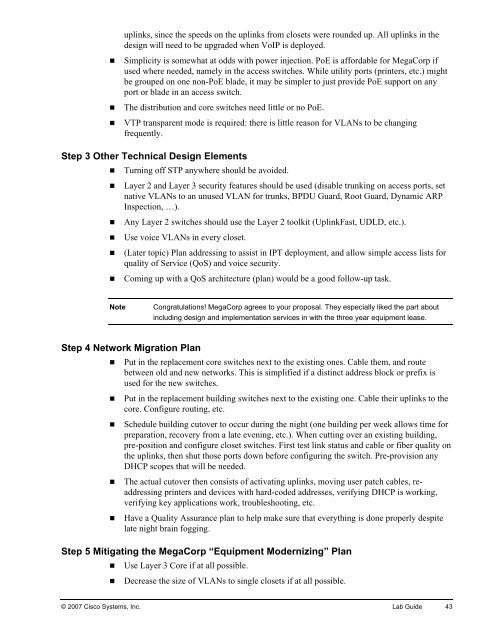Designing Cisco Network Service Architectures - Free Books
Designing Cisco Network Service Architectures - Free Books
Designing Cisco Network Service Architectures - Free Books
Create successful ePaper yourself
Turn your PDF publications into a flip-book with our unique Google optimized e-Paper software.
uplinks, since the speeds on the uplinks from closets were rounded up. All uplinks in thedesign will need to be upgraded when VoIP is deployed.• Simplicity is somewhat at odds with power injection. PoE is affordable for MegaCorp ifused where needed, namely in the access switches. While utility ports (printers, etc.) mightbe grouped on one non-PoE blade, it may be simpler to just provide PoE support on anyport or blade in an access switch.• The distribution and core switches need little or no PoE.• VTP transparent mode is required: there is little reason for VLANs to be changingfrequently.Step 3 Other Technical Design Elements• Turning off STP anywhere should be avoided.• Layer 2 and Layer 3 security features should be used (disable trunking on access ports, setnative VLANs to an unused VLAN for trunks, BPDU Guard, Root Guard, Dynamic ARPInspection, …).• Any Layer 2 switches should use the Layer 2 toolkit (UplinkFast, UDLD, etc.).• Use voice VLANs in every closet.• (Later topic) Plan addressing to assist in IPT deployment, and allow simple access lists forquality of <strong>Service</strong> (QoS) and voice security.• Coming up with a QoS architecture (plan) would be a good follow-up task.NoteCongratulations! MegaCorp agrees to your proposal. They especially liked the part aboutincluding design and implementation services in with the three year equipment lease.Step 4 <strong>Network</strong> Migration Plan• Put in the replacement core switches next to the existing ones. Cable them, and routebetween old and new networks. This is simplified if a distinct address block or prefix isused for the new switches.• Put in the replacement building switches next to the existing one. Cable their uplinks to thecore. Configure routing, etc.• Schedule building cutover to occur during the night (one building per week allows time forpreparation, recovery from a late evening, etc.). When cutting over an existing building,pre-position and configure closet switches. First test link status and cable or fiber quality onthe uplinks, then shut those ports down before configuring the switch. Pre-provision anyDHCP scopes that will be needed.• The actual cutover then consists of activating uplinks, moving user patch cables, readdressingprinters and devices with hard-coded addresses, verifying DHCP is working,verifying key applications work, troubleshooting, etc.• Have a Quality Assurance plan to help make sure that everything is done properly despitelate night brain fogging.Step 5 Mitigating the MegaCorp “Equipment Modernizing” Plan• Use Layer 3 Core if at all possible.• Decrease the size of VLANs to single closets if at all possible.© 2007 <strong>Cisco</strong> Systems, Inc. Lab Guide 43
















